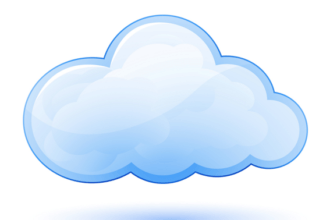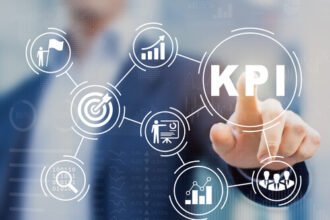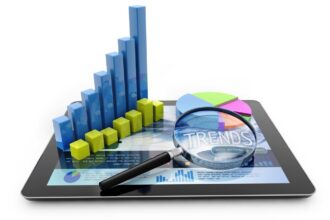Editor’s Note: The highly regarded enterprise IT thought leader Dion Hinchcliffe has produced yet another “must read” piece for enterprise technologists titled “The “Big Five” IT trends of the next half decade: Mobile, social, cloud, consumerization, and big data.” This is classic Dion, with compelling logic, great context, and a tremendo
Editor’s Note: The highly regarded enterprise IT thought leader Dion Hinchcliffe has produced yet another “must read” piece for enterprise technologists titled “The “Big Five” IT trends of the next half decade: Mobile, social, cloud, consumerization, and big data.” This is classic Dion, with compelling logic, great context, and a tremendous graphic that helps put the trends in perspective.
I summarize and extract from Dion’s piece here:
Much has been written lately about the speed at which technology is reshaping the business landscape today. Except that’s not quite phrasing it correctly. It’s more like it’s leaving the traditional business world behind. There are a number of root causes: The blistering pace of external innovation, the divergent path the consumer world has taken from enterprise IT, and the throughput limitations of top-down adoption.
As a result, there’s a rapidly expanding gap between what the technology world is executing on and what the enterprise can deliver. Many now think this gap may actually become untenable, and they may be right. Yet recent large surveys of CIOs continues to show an almost exclusively evolutionary and internal focus. Many feel that a technology emphasis is wrong right now, and they’re certainly right, if it’s not integrated with top priority business objectives. However, these days it’s technology advancements and new digital markets that are often the key to an organization’s future.
A tectonic technology shift
One only need look at what’s on the mind of CIOs these days (60% believe they should be directly driving growth and productivity) versus what they’re well known for delivering on. Or perhaps more problematically, what their IT organizations are able to deliver on. Never in my two decades of experience in the IT world have I seen such a disparity between where the world is heading as a whole and the technology approach that many companies are using to run their businesses.
The issues are legion: There are at least five major “generational scale” changes to the computing landscape happening at about the same time: Delivery platforms are s hifting (mobility, cloud, social), communication and collaboration channels are being reinvented (Web, mobile, social), the consumer world of technology is driving innovation, and data is opening up and exploding out of the proliferating apps, devices, and sensors that organizations are deploying or are connecting to (but alas, are often not engaging with.) And as you might expect, much or most of these topics are in back burner mode in many companies just now seeing the glimmerings of recovery from the downturn.
hifting (mobility, cloud, social), communication and collaboration channels are being reinvented (Web, mobile, social), the consumer world of technology is driving innovation, and data is opening up and exploding out of the proliferating apps, devices, and sensors that organizations are deploying or are connecting to (but alas, are often not engaging with.) And as you might expect, much or most of these topics are in back burner mode in many companies just now seeing the glimmerings of recovery from the downturn.
Moreover, workers are now demanding many of these innovations and expecting their organizations to provide something close in capability to what they can get nearly for free (or actually for free) on their own devices and networks. Managers and executives, albeit mostly on the business side, are typically pushing for 1) service delivery on next-generation mobile devices like the iPad, 2) much easier to use IT solutions, and 3) access to better, more collaborative and useful intranet capabilities.
“Easy”, highly mobile, and “social” are the mantras of this new generation of IT. So to is the rapid (read: instant) acquisition and delivery of business solutions. There is a growing realization amongst workers and management that technology, though increasingly complex in itself, can be wielded far more rapidly and efficiently than their currently parochial capabilities are providing.
But this is not a blame game. IT is not necessarily at fault, or at least only indirectly. Instead, it seems to be the entire structure and process through which organizations absorb and metabolize technology. It’s centralized. It’s controlled. It’s top-down. There are exceptions, but in most organizations, technology decisions are made at high levels and then pushed across the organization. This transmission process is slow and unpredictable. It’s also often not supported on the ground where reality reaches the business.
Unfortunately, the slow-pace of IT adoption, hindered by traditional project management practices, endless customization processes, IT backlogs, security concerns, and a dozen other drags on delivery performance, is only part of the problem. The fact that the technology world is largely no longer driven by the enterprise world (as it used to be for decades) is another major reason that technology and business is having a harder time these days aligning.
A few examples will suffice: The endless and seemingly real-time flow of useful and highly innovative new mobile and Web apps for managing travel, money, news, communication, productivity, and countless other key functions is only an inadequate trickle in the enterprise today. The ability to quickly connect, communicate, and collaborate via social conversations, photos, audio, video, and more with anyone in the world is much more limited currently in most businesses. Finding and acquiring new software is just the click of a button in an app store in the consumer world, but an arduous, manual, and failure prone process in most organizations now. User experiences are changing: The aging and slow-to-evolve graphical user interface is being uprooted by touch based interfaces in new consumer apps that work much better in many physical situations. In contrast, the same overhaul is happening an order of magnitude more slowly for business apps.
Where does technology and IT go from here?
If we project these trends forward, what will the outcome be? Is there going to be a final fork in the road for consumer and enterprise technology, with each side looking at each other through a diverging pair of windows, with minimal crossover between the two? Or will the two worlds continue to blur together, as technology cross-pollinates from the growing wall of innovation coming from the Web and consumer technology world? Given the virality and pervasiveness of consumer technology, the latter is by far the most likely scenario.
So what are the key IT trends of the next half decade? How will organizations adapt to them? In a conversation I had recently with the Editor-in-Chief of CIO Magazine, Maryfran Johnson, we discussed what I dubbed the “Big Five”, the biggest technology influences of the next half decade. This includes next-gen mobility, social media (or more specifically social business), cloud computing, consumerization, and big data. We agreed that these five — of all current tech trends — are at top of the list for what most organizations need to be planning for in their current strategies and roadmaps as they update and modernize, as well as (hopefully) out-innovate their competitors.
1) Next-Gen Mobile – Smart Devices and Tablets
It’s obvious to the casual observer these days that smart mobile devices based on iOS, Android, and even Blackberry OS/QNX are seeing widespread use. But comparing projected worldwide sales of tablets and PCs tells an even more dramatic story. Using the latest sales projections from Gartner on tablets and current PC shipment estimates from IDC, we can see that by 2015 the tablet market will be 479 million units and the PC market will be only just ahead at 535 million units. This means tablets alone are going to have effective parity with PCs in just 3 years. Other data I’ve seen tells a similar story.
So, while it’s still early days yet, it’s also quite clear that enterprises must start treating tablets as equal citizens in their IT strategies. So why won’t they? For several reasons:
Key adoption insight
A likely approach that will scale is to do as JP Rangaswami advocates, and “design for loss of control.” This doesn’t mean letting go of essential control such as robust security enforcement, but it does mean providing a framework for users to bring their own mobile devices to work in a safe manner, including use of apps with business data under certain prescribed conditions. This unleashes choice and innovation and vitally, splits the work of adoption and rollout with users that want to use their favorite mobile devices/app to solve a business problem.
2) Social Media – Social Business and Enterprise 2.0
While mobile phones technically have a broader reach than any communications device, social media has already surpassed that workhorse of the modern enterprise, e-mail. Increasingly, the world is using social networks and other social media-based services to stay in touch, communicate, and collaborate. Now key aspects of the CRM process are being overhauled to reflect a fundamentally social world and expecting to see stellar growth in the next year. As Salesforce’s Marc Benioff was very clear in his dramatic keynote at Dreamforce last month, leading organizations are becoming social enterprises.
There now seems to be hard data to confirm this view: McKinsey and Company is reporting that the revenue growth of social businesses is 24% higher than less social firms and data from Frost and Sullivan backs that up across various KPIs. The message is that companies are going to — and have every reason to — be using social media as a primary channel in the very near future, if they aren’t already. It’s time to get strategic.
Key adoption insight
There are a growing number of established social media adoption strategies, but probably one of the most effective is to engage by example. Both leadership inside the company as well as top representatives to the outside world must engage in social channels to show how they’d like change to happen.
Related: Reconciling the enterprise IT portfolio with social media
3) Cloud computing
Of all the technology trends on this list, cloud computing is one of the more interesting and in my opinion, now least controversial. While there are far more reasons to adopt cloud technologies than just cost reduction, according to Mike Vizard perceptions of performance issues and lack of visibility into the stack remain one of the top issues for large enterprises. Yet, among the large enterprise CTO and CIOs I speak with, cloud computing is being adopted steadily for non-mission critical applications and some are now even beginning to downsize their data centers. Business agility, vendor choice, and access to next-generation architectures are all benefits of employing the latest cloud computing architectures, which are often radically advanced compared to their traditional enterprise brethren.
Key adoption insight
Until cloud computing workloads can be seamlessly transferred back and forth between a company’s private cloud and public/hybrid cloud, adoption will be held back and favored largely for greenfield development. Technologies are now emerging to make this possible, however, and for now, companies should invest in cloud standards (to the extent they exist today) to build private clouds in order to be in position to start selectively transferring services out on a trial basis (and being able to bring them back in safely as needed.)
Related: Fixing IT in the cloud computing era.
4) Consumerization of IT
I’ve previously made the point that the source of innovation for technology is coming largely from the consumer world, which also sets the pace. Yet that’s just one aspect of consumerization, which some like myself and Ray Wang are calling “CoIT” for short. Consumerization also very much has to do with its usage model, which eschews enterprise complexity for extreme usability and radically low barriers to participation. Enterprises which don’t steadily consumerize their application portfolios are in for even lower levels of adoption and usage than they already have as workers continue to route around them for easier and more productive solutions. Another decentralized and scalable solution is, as with next-gen mobile, to help workers help themselves to third party apps that are deemed safe and secure.
Key adoption insight
Consumerization seems especially pernicious to IT departments because it happens all the time, without their involvement. Stats vary on “shadow IT”, which is in the lower double digits, but much of it is for consumer apps. IT departments can begin programs in partnership with other large companies (to distribute the work) to certify SaaS, cloud, and mobile apps and train workers on data safety, backup, and integrity for example. Longer term, companies will imbue their IT service design, solution acquisition, and delivery with user experience and design approaches and fresh ideas from the consumer world. This will drive more worker productivity, less user support, and higher innovation in IT solutions.
5) Big data
Businesses are drowning in data more than ever before, yet have surprisingly little access to it. In turn, business cycles are growing shorter and shorter, making it necessary to “see” the stream of new and existing business data and process it quickly enough to make critical decisions. The term “big data” was coined to describe new technologies and techniques that can handle an order of magnitude or two more data than enterprises are today, something existing RDBMS technology can’t do it in a scalable manner or cost-effectively.
Big data offers the promise of better ROI on valuable enterprise datasets while being able to tackle entirely new business problems that were previously impossible to solve with existing techniques. While most companies are still addressing their big data needs with data warehousing, according to Loraine Lawson, one need only scan the impressive McKinsey report on Big Data to see the major opportunities it offers on the business side.
Related: The enterprise opportunity of Big Data: Closing the “clue gap”
Key adoption insight
Big data requires a mindset change as much as a technology update. This means making open data a priority for the enterprise as well as an operational velocity that hasn’t been a priority before. Big data enables solving new business problems in windows that weren’t possible before. It also means infrastructure, ops, and development must be part of the same team and used to working together. This means organizational refinements must be made to tap into the greater potential.
How IT can evolve to meet the Big Five
I’m beginning to see that in order to stay relevant, and not become the PBX department, IT departments must be prepared to take a “Big Leap” to meet the Big Five. What this Big Leap looks like will be different for every organization, and their are multiple directions that can be taken. As I wrote on Twitter recently, the deeply transformational nature of most of the Big Five means IT must either start leading the business models and evolution of the organization, or become a commoditized utility while the business figures out the moves on their own. This almost certainly means open supply chainsand enabling strategic IT abundance via designed loss of control coupled with emergent and agile approaches to IT. Now that I’ve explored the Big Five, I’ll take a look at the Big Leap soon and see what the options are for IT — such as “The Next Generation Enterprise Platform” that Michael Fauscette recently posited — to not only remain relevant in the 21st century, but become the driver of business.
Editor’s comment: For the full article see: ”The “Big Five” IT trends of the next half decade: Mobile, social, cloud, consumerization, and big data” and for more on Dion see: Dion Hinchcliffe.










